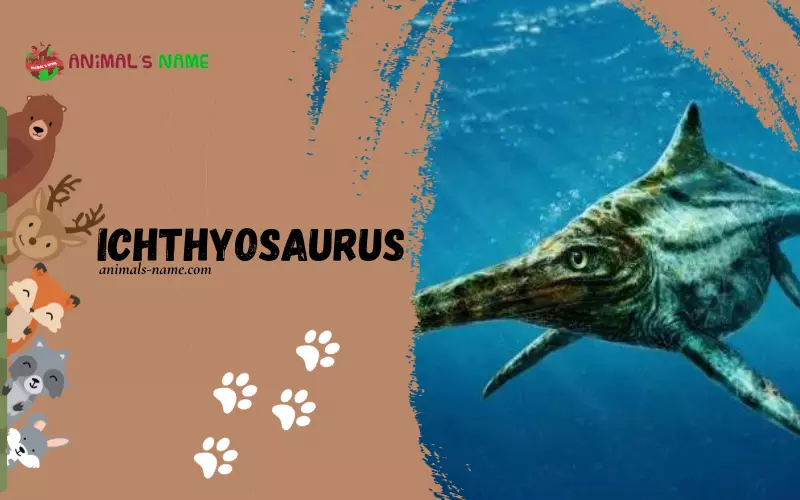Ichthyosaurus, a fascinating species classified under reptiles, has a rich and intriguing history. This aquatic creature lived in the oceans around 200 million years ago during the Jurassic era. Its name, derived from the Greek words “fish lizard,” perfectly describes its appearance and lifestyle. Despite its name, the Ichthyosaurus was not an actual fish but a reptile that shared similarities with modern-day dolphins.
The Ichthyosaurus was an impressive sight in the prehistoric seas, with an average size ranging from 6 to 10 feet. Its long and streamlined body, powerful flippers and a large tail enabled it to glide through the water with incredible agility. These adaptations made it an efficient predator, preying on smaller marine animals such as fish and squid.
The Ichthyosaurus was known for its wide distribution, inhabiting a vast range of warm, shallow seas across Europe and North America. Its fossils have been found in various locations, providing valuable evidence about its lifestyle and evolution. By studying these fossils, scientists have classified the Ichthyosaurus as a member of the reptile group known as “Ichthyosauria,” including other extinct marine reptiles.
History of Ichthyosaurus

The Ichthyosaurus reptile lived a very long ago, during the Mesozoic Era. This era is also known as the Age of Dinosaurs. The Ichthyosaurus was fascinating because it lived on land and in the water. It had a body shape similar to modern dolphins, with a long snout and a streamlined body that helped it glide through the water. Its name means “fish-lizard” because of its fish-like features.
During the Mesozoic Era, the world looked very different than it does today. The continents were in different positions, and the climate was warmer. The oceans were full of many different types of marine life, including the Ichthyosaurus. These reptiles were well-adapted to life in the water. They had flippers instead of legs, making swimming and catching their prey easier. Their sharp teeth were perfect for eating fish and other small marine animals.
Scientists have discovered many fossils of Ichthyosaurus all around the world. These fossils have helped them learn more about these exciting creatures. They found that Ichthyosaurus gave birth to live young like modern dolphins. They have also found evidence of their diet and how they moved in the water. Ichthyosaurus were very successful predators and existed for millions of years before becoming extinct.
The Ichthyosaurus was a fascinating reptile from the Mesozoic Era. It lived on land and in the water, and its body shape was similar to modern dolphins. It had flippers and sharp teeth that helped it swim and catch prey. Fossils have taught us a lot about the Ichthyosaurus and how it lived. It was a successful predator but eventually became extinct like many other creatures from that period.
Importance of Ichthyosaurus
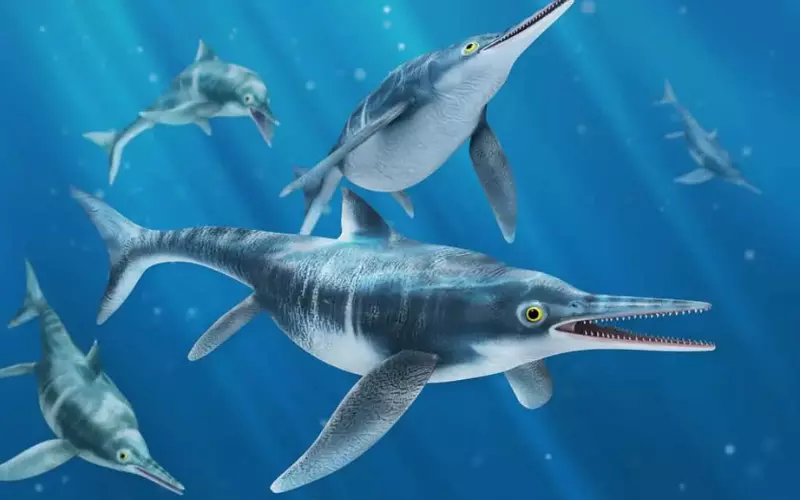
The Ichthyosaurus reptile is very important because it helps us to learn more about prehistoric times. By studying this ancient creature, scientists can understand what life was like millions of years ago. This information is essential for understanding how our planet has changed over time.
One reason why the Ichthyosaurus is essential is because it helps scientists learn about evolution. By examining its physical features and comparing them to other animals, they can see how species have changed and adapted over millions of years. This research is crucial for understanding the diversity of life on Earth.
Another reason the Ichthyosaurus is significant is because it gives us insights into the oceanic ecosystems of the past. As a marine reptile, it highlights the importance of the oceans in supporting diverse life forms. Scientists can learn about the ancient food webs, habitats, and ocean interactions long ago by studying the Ichthyosaurus.
The Ichthyosaurus reptile is vital because it provides information about evolution and ancient marine ecosystems. By studying this prehistoric creature, scientists can understand the changes on our planet and the role the oceans play in supporting life.
Amazing Facts About Ichthyosaurus

1. Ichthyosaurus is an extinct marine reptile that lived 245-90 million years ago during the Mesozoic Era.
2. Its name means “fish lizard” in Greek, reflecting its streamlined body shape and aquatic lifestyle.
3. Ichthyosaurus had a long, dolphin-like snout, which helped it catch fish and other small marine creatures.
4. Its sleek, streamlined body allowed it to swim quickly through the water.
5. Ichthyosaurus had four flippers, which it used to steer and propel through the water.
6. It could grow to lengths ranging from about 2 meters to up to 6 meters, depending on the species.
7. Ichthyosaurus had large, forward-facing eyes, indicating it relied on good eyesight to hunt for prey.
8. Fossil evidence suggests that it gave birth to live young, a characteristic in some modern marine mammals.
9. It had sharp teeth, perfect for capturing and eating prey.
10. Ichthyosaurus had a flexible body and a tail with a vertical tail fin, allowing it to swim swiftly and change direction quickly.
11. It had a streamlined body shape that helped reduce drag in the water.
12. Ichthyosaurus likely had a layer of fat to help keep it warm in the cold marine environments it inhabited.
13. Various species of Ichthyosaurus existed, with some having different body shapes and sizes.
14. They were widely found in various parts of the world, including Europe, North America, Asia, and Australia.
15. Ichthyosaurus is an essential species in the study of palaeontology, providing valuable insights into the evolution of marine reptiles and their adaptations to an aquatic lifestyle.
Can we keep Ichthyosaurus as our Pet?
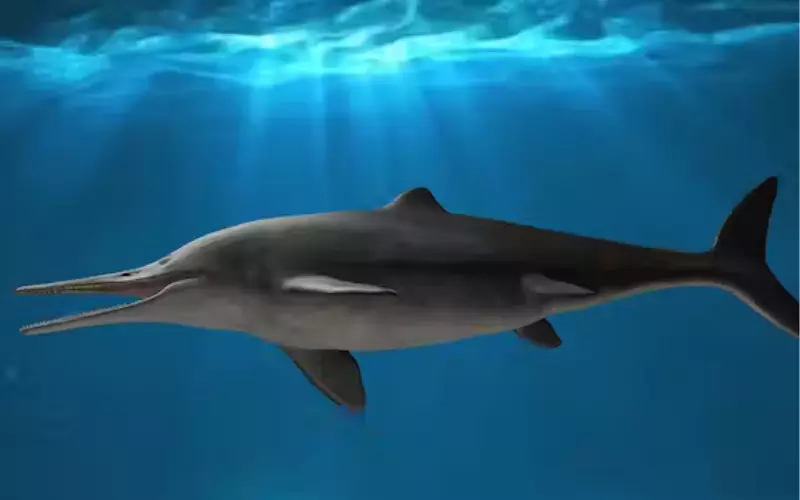
The Ichthyosaurus is a fantastic reptile that lived a long time ago. However, we cannot keep it as a pet because it is extinct now. This means that there are no more Ichthyosaurus reptiles left in the world.
The Ichthyosaurus lived in the oceans around 200 million years ago. It had a long, streamlined body like a dolphin, which helped it swim very fast. It also had sharp teeth to catch fish and other small creatures. Sadly, the Ichthyosaurus became extinct about 90 million years ago. This happened because of significant environmental changes, like temperature changes and food availability. These changes made it hard for the Ichthyosaurus to survive; sadly, they could not adapt to their new surroundings.
Since the Ichthyosaurus is no longer alive, we cannot keep them as pets. It is essential to understand that it is impossible to keep extinct pets because we cannot find them anymore. Although learning about these fascinating creatures might be fun, it is better to focus on studying and protecting the still-alive animals. This way, we can help ensure they do not meet the same fate as the Ichthyosaurus.
Size of Ichthyosaurus

Ichthyosaurus was a giant marine reptile that lived during the time of dinosaurs, about 250 million years ago. It is known for its streamlined body and fish-like features, which helped it swim swiftly through the ancient oceans. In terms of size, Ichthyosaurus varied depending on the species, but they ranged from around 6 to 16 feet in length.
The body of Ichthyosaurus was shaped like a torpedo, which made it very agile in the water. Its long, slender tail and four flippers allowed it to manoeuvre easily. Its body was covered in smooth, scale-like skin as a protective layer. This reptile had a cone-shaped snout and sharp teeth, perfect for catching fish and other small marine creatures.
Some species of Ichthyosaurus had a slightly larger size compared to others. For example, Ichthyosaurus communis was one of the most common species, and it usually reached lengths of about 6 to 10 feet. On the other hand, the larger species, such as Ichthyosaurus somersetensis, could grow up to 16 feet long. These reptiles were truly impressive in size, especially considering they lived during a time when many other creatures were also evolving into giants.
Ichthyosaurus was a fascinating marine reptile that lived millions of years ago. Its streamlined body, flippers, and sharp teeth made it a formidable swimmer and hunter in the ancient oceans. While the size of Ichthyosaurus varied between species, they ranged from around 6 to 16 feet in length. It was undoubtedly an extraordinary creature from a time long gone.
Habitat of Ichthyosaurus
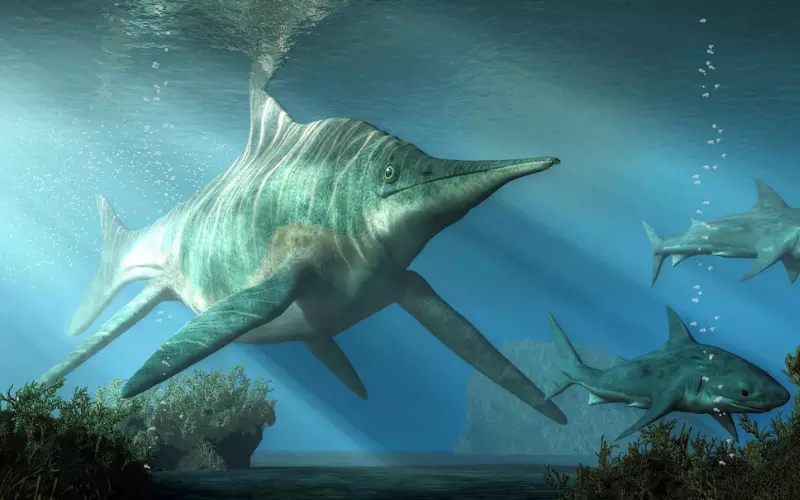
Ichthyosaurus reptile, a fascinating creature from the past, used to swim and live in a habitat much different from what we see today. They thrived around 200 million years ago during the Mesozoic Era when the Earth’s climate and geography differed significantly.
These magnificent reptiles resided in the ancient oceans that covered the regions we now call Europe and the Americas. They preferred the warm and shallow waters of the seas, where they could easily find food and escape from larger predators. Unlike dolphins or whales, ichthyosaurus reptiles couldn’t survive in intense waters or cold ocean currents.
Their home, the ancient oceans, was teeming with various forms of marine life that provided an abundant food source for Ichthyosaurus reptiles. They were skilled hunters, preying on fish, squid, and even smaller reptiles. With their streamlined bodies and muscular tails, they were perfectly adapted for swimming swiftly and gracefully through the water, making them powerful predators.
The habitat of the Ichthyosaurus reptile was an underwater world of opportunities and challenges. They encountered a wide range of species, some of which they hunted, while others posed dangers to them. Despite these risks, Ichthyosaurus reptiles successfully adapted to their environment, showing us how remarkable and resilient these ancient creatures were. Their habitat allowed them to flourish in the primaeval seas and become one of the most remarkable reptiles of their time.
Evolution of Ichthyosaurus
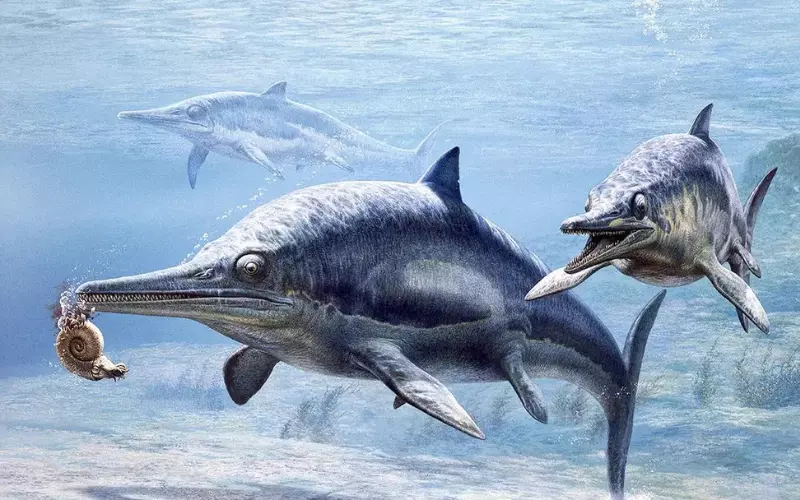
Ichthyosaurus is a fascinating reptile that lived during the Mesozoic Era, specifically during the Early Jurassic period, about 200 million years ago. It was an incredible swimmer with many adaptations that allowed it to thrive in an aquatic environment.
The evolution of Ichthyosaurus can be traced back to its ancestors, land-dwelling reptiles. These early reptiles evolved, developing adaptations that allowed them to live and hunt in the water. They gradually transformed from solid and agile on land to become streamlined and efficient swimmers in the ocean. This evolution took millions of years and involved changes in their bone structure, such as developing a long and flexible tail, solid and streamlined limbs, and the loss of heavy armour.
As Ichthyosaurus continued to evolve, it further adapted to its aquatic lifestyle. It had a streamlined body, similar to modern dolphins’, allowing it to quickly and efficiently through the water. Its limbs gradually transformed into paddle-like structures, enabling it to quickly propel itself through the ocean. Additionally, its tail became more powerful, aiding in steering and locomotion underwater.
Overall, the evolution of Ichthyosaurus showcases the incredible ability of organisms to adapt and change over time. From its land-dwelling ancestors, it evolved into a highly specialized marine reptile, ideally suited for life in the ocean. Its streamlined body, paddle-like limbs, and powerful tail allowed it to become an exceptional swimmer, emphasizing the diversity and adaptability found in the natural world.
Classification of Ichthyosaurus

Ichthyosaurus is a type of reptile that lived a very long time ago, during the Mesozoic era. It is classified as a marine reptile, which means it lives in the ocean. The word “ichthyosaurus” actually means “fish lizard” in Greek, and this name is very fitting because the creature had a long and sleek body with fins, just like a fish!
In terms of classification, Ichthyosaurus is in the order Ichthyosauria, which is a group of extinct marine reptiles. They are further classified into the family Ichthyosauridae and the genus Ichthyosaurus. There are different species within this genus, such as Ichthyosaurus communis and Ichthyosaurus breviceps, which vary in size and shape.
Ichthyosaurus had some unique features that set it apart from other reptiles. Its streamlined body with a powerful tail helped it quickly swim through the water. Its limbs were transformed into flippers, similar to what we see in dolphins or seals, for efficient movement in the ocean. They had sharp teeth and a strong jaw, which enabled them to catch and devour their prey, mainly fish and squid.
Ichthyosaurus is a fascinating marine reptile that lived long ago. Its classification as an ichthyosaur places it among the extinct marine reptiles group; within this group, it is further classified into the genus Ichthyosaurus. With its fish-like body, flippers, and sharp teeth, Ichthyosaurus was well adapted to hunting and surviving in the ancient oceans.
Different Types of Ichthyosaurus
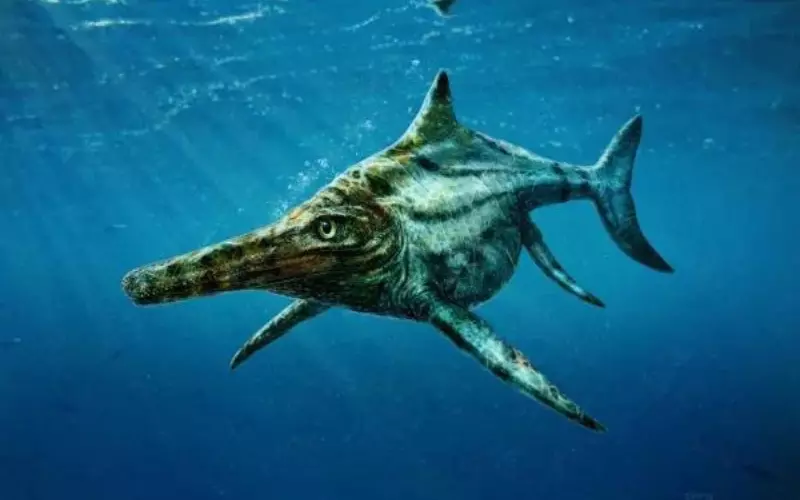
1. Ichthyosaurus communis: This was the most common type of Ichthyosaurus, measuring up to 20 feet long. It had a streamlined body, a dolphin-like snout, and sharp teeth for catching fish. It lived in the Jurassic period and is known from numerous fossil findings.
2. Ichthyosaurus acutirostris: This species had a slender body, reaching lengths of up to 9 feet. Its pointed snout and long teeth were adapted for hunting fast-moving prey. Fossils indicate it lived in the Late Triassic to Early Jurassic periods.
3. Ichthyosaurus breviceps: With a stout body and short snout, this Ichthyosaurus species could feed on a range of prey. It lived during the Early Jurassic period, characterized by its short, rounded head and robust build.
4. Ichthyosaurus intermedius: This species falls between I. communis and I. breviceps in size, measuring around 10-13 feet in length. It had a flexible body and a snout filled with sharp teeth. Fossil evidence suggests it lived during the Early Jurassic period.
5. Ichthyosaurus platyodon: With a broad snout and teeth adapted for crushing shellfish, this species fed on a different diet than other Ichthyosaurus types. Fossils have been found in deposits from the Early Jurassic period.
6. Ichthyosaurus somersetensis: Named after a county in England, this species lived during the Early Jurassic period. Fossils indicate it had a long snout and slender body, similar to I. acutirostris, suggesting they may have occupied similar ecological niches.
7. Ichthyosaurus trigonus: Specimens of this species are rare, but it is believed to have lived during the Early Jurassic period. Its elongated body was streamlined for rapid swimming, and its pointed snout helped it catch small fish.
8. Ichthyosaurus tenuirostris: This Ichthyosaurus type had a slender body and a narrow, pointed snout. Fossil evidence suggests it lived during the Early Jurassic period and would have preyed on small fish and marine invertebrates.
9. Ichthyosaurus conybeari: Named after the geologist William Conybeare, this species was characterized by its large size, reaching approximately 27 feet long. It had a long snout and sharp teeth, likely hunting fast-moving fish. It lived during the Early Jurassic period.
10. Ichthyosaurus breviceps: This species had a robust body and short snout filled with sharp teeth. Its fossils date back to the Early Jurassic period. Its sturdy build suggests it may have been capable of chasing and capturing larger prey than other Ichthyosaurus types.
Geographical Presence of Ichthyosaurus

The Ichthyosaurus reptile is mainly found in the region known as Europe, specifically in countries such as England, Germany, and France. These countries have been significant areas for fossil discoveries of this ancient marine reptile. The remains of Ichthyosaurus have been found in places like the UK’s Jurassic Coast, the limestone quarries of Germany, and the chalk cliffs of France.
However, these fascinating reptiles are not found in other regions, such as Asia, Africa, or the Americas. This is because the specific geological conditions required for forming and preserving Ichthyosaurus fossils were present in Europe during the Jurassic period. The ancient oceans of Europe provided an ideal environment for these reptiles to thrive and eventually become fossilized.
It is important to note that the Ichthyosaurus reptile lived millions of years ago and is now extinct. Therefore, you will not find any living Ichthyosaurus anywhere today. To study and learn about these creatures, we rely on the fossils carefully preserved and unearthed by scientists, allowing us to understand their existence, behaviour, and evolution during prehistoric times.
Scientific Name of Ichthyosaurus
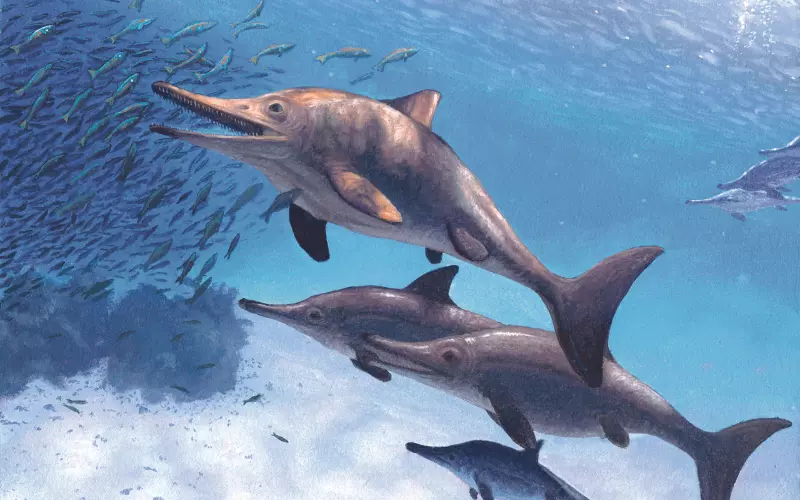
The scientific name for the Ichthyosaurus reptile is Ichthyosaurus. This name comprises “ichthyo,” which means fish, and “saurus,” which means lizard. This name was given to the reptile because its body was shaped like a fish, but it was a lizard.
Ichthyosaurus lived in the ocean during the time of the dinosaurs, around 200 million years ago. It was a fascinating creature with a long, sleek body, similar to a dolphin. It had different adaptations to help it survive in the water, such as a streamlined shape, flippers for swimming, and a long snout to catch fish.
Scientists have discovered many fossils of Ichthyosaurus, which has helped them learn more about this ancient reptile. They have found its bones, teeth, and sometimes even preserved soft tissues. Studying these fossils has allowed scientists to understand how Ichthyosaurus lived, what it ate, and how it moved in the water.
Ichthyosaurus is a unique reptile with a scientific name that reflects its fish-like appearance. It lived in the ocean millions of years ago and had adaptations that helped it survive in its marine habitat. Fossils of Ichthyosaurus have provided valuable information about its biology and lifestyle, giving scientists a glimpse into the past.
Diet of Ichthyosaurus
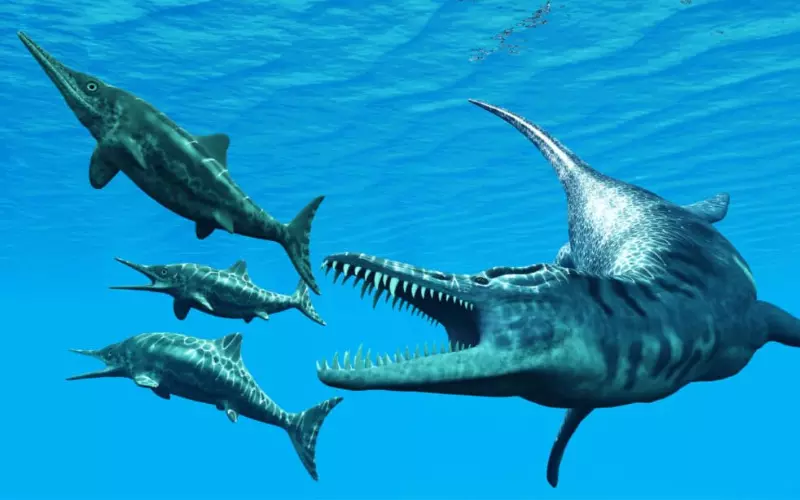
The ichthyosaurus reptile had a special diet that helped it survive and thrive in the ancient oceans. Its main source of food was fish. These reptiles were terrific swimmers, using their speed and agility to chase after schools of fish. Their sharp teeth helped them catch their prey easily. Like how we eat different kinds of food to stay healthy, the ichthyosaurus relied on fish to get the nutrients needed to grow and stay strong.
The ichthyosaurus also had a keen sense of sight, which helped it spot fish from a distance. It would then use its streamlined body to swim towards its target quickly. Once close enough, it would open its mouth wide and snatch the fish in a single gulp. This made it an efficient hunter in the water.
Apart from fish, some scientists believe that the ichthyosaurus may have also eaten squid and other small marine creatures. These reptiles had a varied diet, which allowed them to adapt to different environments and survive in different conditions.
The ichthyosaurus reptile had a diet of mainly fish, but it also ate other small marine creatures. Its sharp teeth and excellent swimming skills helped it catch its prey easily. By understanding what the ichthyosaurus ate, scientists can learn more about its lifestyle and how it lived in the ancient oceans.
Locomotion of Ichthyosaurus

The Ichthyosaurus is a reptile that lived long ago, and its way of moving in the water was truly unique. It had a body like a fish with a long tail and streamlined shape. This helped it to swim swiftly and efficiently through the water.
When the Ichthyosaurus wanted to move forward, its muscular tail would push against the water, propelling itself forward. As it moved its tail side to side, the reptile would swim like a dolphin, gracefully gliding through the waves. Because of its streamlined body, the Ichthyosaurus could quickly change direction and even jump out of the water, like a little fish leaping out of its fishbowl.
The locomotion of the Ichthyosaurus was well-suited for its life in the water. It was like a master swimmer, using its powerful tail to manoeuvre through the depths of the seas. With its sleek body and tail, the Ichthyosaurus could swim fast, turn quickly, and easily explore the underwater world.
Social and Sexual Behaviour of Ichthyosaurus
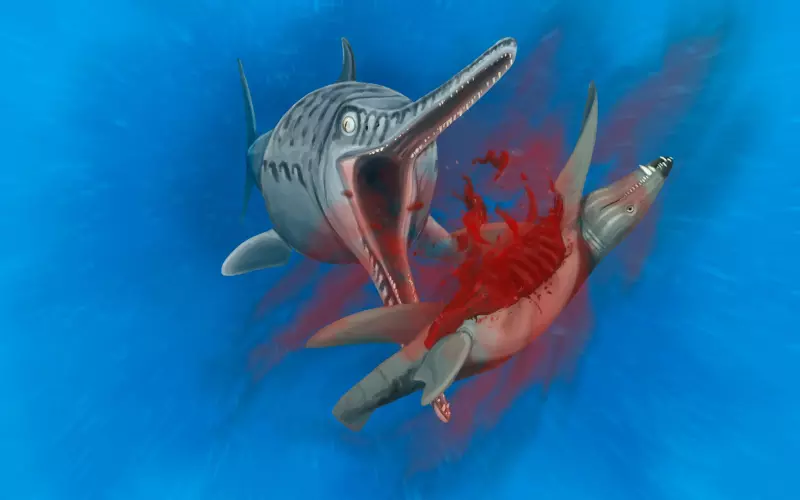
Ichthyosaurus is a kind of reptile that lived many years ago. They had interesting social and sexual behaviours. These behaviours helped them survive and have babies.
Firstly, Ichthyosaurus lived in groups called pods. They liked to stay together, just like dolphins do. Being in a group made them safer because they could protect each other from predators. They also liked swimming and hunting in groups, making catching food easier. Living in pods also helped them find mates for reproduction.
Secondly, Ichthyosaurus had a unique way of reproducing. The males had a particular organ called a “clasper”, which they used to mate with females. The males would swim close to the females and insert their clasper into the female’s body to fertilize the eggs. This is similar to how some sharks reproduce. After mating, the females lay eggs in the water or give birth to live babies.
Ichthyosaurus was a gregarious reptile that lived in groups and had interesting reproducing methods. They were social animals that liked to swim, hunt, and mate together. It’s fascinating to learn about these ancient creatures and how they lived their lives.
Reproduction and Lifecycle of Ichthyosaurus
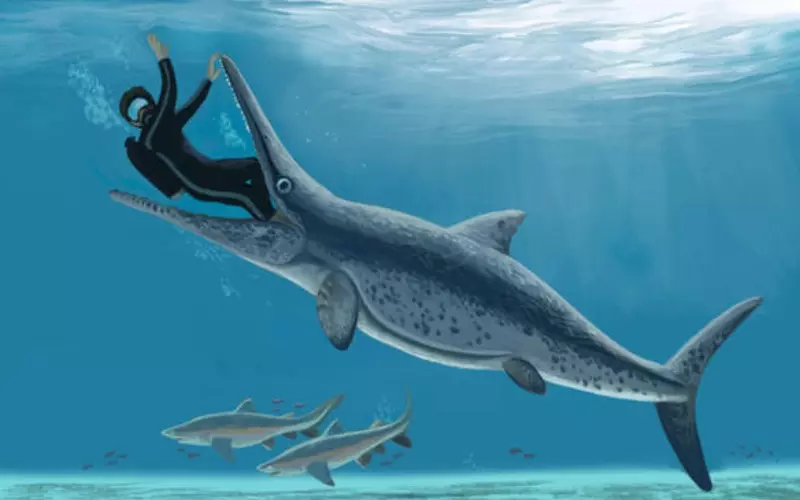
Ichthyosaurus is a fascinating reptile that lived long ago. It had a fascinating life cycle and a unique way of reproducing. Let’s learn more about it!
The life cycle of Ichthyosaurus began when a female reptile laid eggs in the water. The eggs were not like the ones we see today; instead, they had a soft shell. These eggs were very vulnerable and had to be protected by the female until they hatched. The female would lay her eggs in a safe place, often in a sandy area near the shoreline. She carefully covered them with sand to protect them from predators and other dangers.
After incubation, the eggs hatched, and tiny Ichthyosaurus babies emerged. These babies were miniature versions of their parents and were ready to explore the world. They had to learn quickly how to swim and find their food. It was challenging for them as many predators lurked in the water, waiting to catch them. Only the strongest and fastest could survive.
As the Ichthyosaurus grew older, they went through a process called metamorphosis. During this time, their body changed, and they developed features different from their juvenile stage. For example, they grew larger, their fins became more robust, and they specialised in swimming. They also developed sharp teeth to help them catch their prey. The Ichthyosaurus became better equipped to hunt and survive in the water with these changes.
The life cycle of Ichthyosaurus was unique. It began with the laying of soft-shelled eggs by the female, followed by the hatching of the babies and their journey to survive in the water. As they grew older, they underwent metamorphosis and developed specialized features that made them efficient swimmers and hunters. It was indeed a remarkable process of growth and adaptation.
Threats to Ichthyosaurus
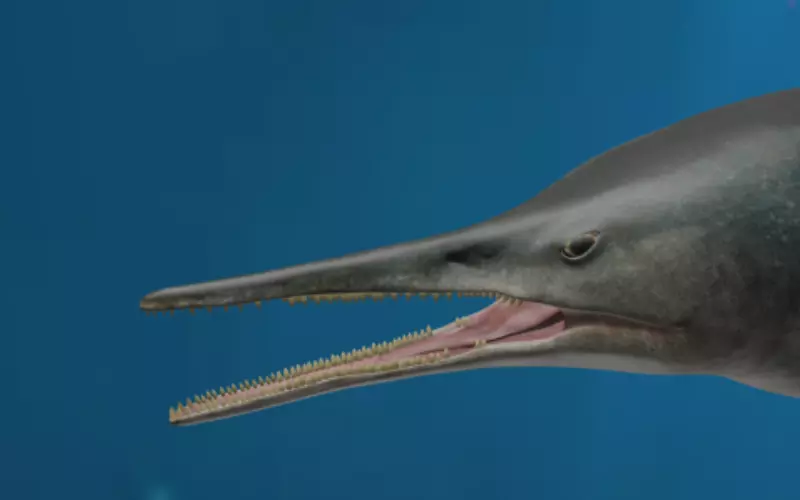
The Ichthyosaurus reptile, an ancient creature that lived millions of years ago, faced several threats during its time. One significant threat to the Ichthyosaurus was competition for food. As a marine reptile, the Ichthyosaurus relied on a diet of fish and other sea creatures. However, with limited resources available in the ocean, the Ichthyosaurus had to compete with other predators that hunted similar prey. This competition for food posed a constant threat to the survival of the Ichthyosaurus.
Another threat that the Ichthyosaurus faced was predation. Although it was a powerful swimmer and had specialized adaptations to help it catch prey, the Ichthyosaurus was not invincible. It had several natural predators, such as more giant marine reptiles like the Mosasaurus and Plesiosaurus, capable of overpowering and feeding on the Ichthyosaurus. This predation risk made it even more challenging for the Ichthyosaurus to thrive in its marine environment.
Lastly, changes in the environment posed a significant threat to the Ichthyosaurus. Climate change, fluctuating sea levels, and variations in water temperature could all impact the Ichthyosaurus and its habitat. For example, a decrease in sea level could restrict the distribution of food sources, making it harder for the Ichthyosaurus to find enough food. Similarly, changes in water temperature could affect the Ichthyosaurus’ ability to regulate its body temperature, potentially leading to health problems and reduced survival rates.
To summarize, the Ichthyosaurus reptile faced threats such as competition for food from other marine predators, predation by more giant reptiles, and environmental changes, including climate fluctuations and sea level variations. These challenges created a precarious existence for the Ichthyosaurus, and its survival relied on its ability to adapt and find enough resources to sustain itself in its ancient marine ecosystem.
Population of Ichthyosaurus
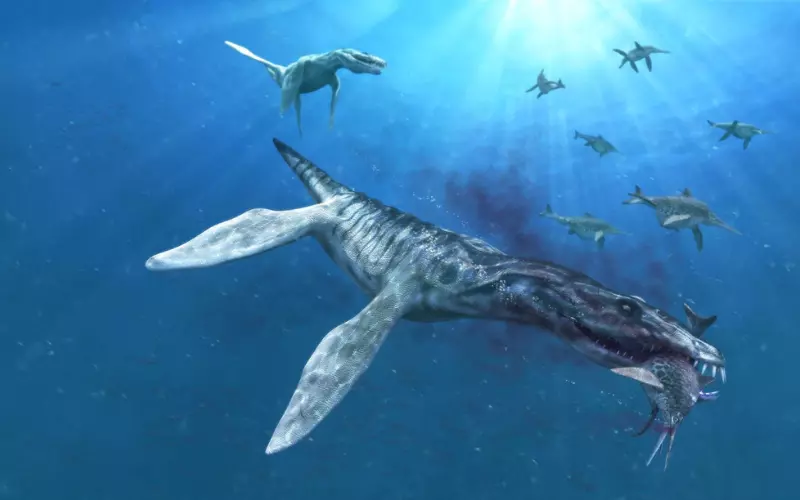
The population of the Ichthyosaurus reptile, which lived during the time of the dinosaurs, is challenging to determine accurately. Scientists estimate these prehistoric creatures thrived in the oceans millions of years ago. While there is no exact number, it is believed that their population was likely relatively abundant due to their adaptations for marine life.
Unfortunately, the Ichthyosaurus reptile is now extinct, meaning it no longer exists today. The reasons for their extinction are still somewhat unclear, but scientists believe various factors may have contributed to their demise. Changes in the Earth’s climate and sea levels, as well as competition for food and predators, could have played a role in driving them to extinction.
Today, we can only study and learn about the Ichthyosaurus through fossils and the clues they leave behind. These unique reptiles had streamlined bodies, similar to dolphins, and were well adapted for life in the ocean. While their population no longer exists, their fossils provide valuable insights into the ancient world and help us understand the diverse creatures that once inhabited our planet.
Conclusion
To sum up, the Ichthyosaurus is a fascinating reptile from the past. Its discovery by Mary Anning in the early 19th century created quite a stir in the scientific community. This ancient creature lived during the time of the dinosaurs and adapted to life in the sea.
The Ichthyosaurus was a giant reptile growing up to 6 meters in length. Its body was streamlined, and its limbs were modified into flippers, enabling it to move swiftly through the water. Fossil evidence suggests it had a warm-blooded metabolism, similar to modern-day mammals. This allowed it to regulate its body temperature and activity in cold waters.
The Ichthyosaurus inhabited the oceans around 200 million years ago. Its fossils have been found in various parts of the world, including Europe and North America. Its sharp teeth indicate it was a predator, feeding on squid, fish, and other small marine creatures. It is believed that this reptile gave birth to live young, a characteristic shared by some modern reptiles such as snakes and lizards.
The Ichthyosaurus was an extraordinary reptile that lived millions of years ago. Its unique adaptations and size make it a captivating creature to study. Although it is now extinct, its fossils provide valuable information about the ancient world and the diversity of reptiles. The Ichthyosaurus remains an integral part of our understanding of Earth’s history and the evolution of reptiles.
Frequently Asked Questions about Ichthyosaurus (FAQ’s)
What is an Ichthyosaurus?
Ichthyosaurus is an extinct marine reptile that lived during the time of the dinosaurs.
How big did Ichthyosaurus grow?
Ichthyosaurus could range in size from about 1.2 meters (4 feet) to over 3 meters (10 feet) in length.
When did Ichthyosaurus exist?
Ichthyosaurus lived during the Early Jurassic period, approximately 250 million years ago.
Where have Ichthyosaurus fossils been found?
Fossils of Ichthyosaurus have been found in Europe, particularly in England and Germany.
What did Ichthyosaurus eat?
Ichthyosaurus was a carnivorous reptile that fed on a diet of fish and cephalopods.
Did Ichthyosaurus give live birth or lay eggs?
It is believed that Ichthyosaurus gave live birth, similar to modern dolphins.
How did Ichthyosaurus swim?
Ichthyosaurus had a streamlined body and a fish-like tail, which enabled it to swim efficiently through the water.
Did Ichthyosaurus have any predators?
While it is difficult to determine, it is possible that larger marine predators, such as pliosaurs and mosasaurs, could have preyed upon Ichthyosaurus.
Was Ichthyosaurus a social animal?
Based on fossil evidence, it is suggested that Ichthyosaurus may have lived in groups or pods similar to modern-day dolphins.
Did Ichthyosaurus have any particular adaptations for living in water?
Ichthyosaurus had streamlined bodies, large eyes, and paddle-like limbs, which helped it navigate and hunt in the marine environment.
Could Ichthyosaurus breathe underwater?
Ichthyosaurus had to come to the water’s surface to breathe, similar to modern marine reptiles like sea turtles.
What is the closest living relative to Ichthyosaurus?
The closest living relative to Ichthyosaurus is the common lizard, although they are not direct ancestors.
How long did Ichthyosaurus live?
Ichthyosaurus’ lifespan is challenging to determine accurately, but it is estimated to have been around 20 to 30 years.
How many species of Ichthyosaurus are known?
There are currently about 15 recognized species of Ichthyosaurus, with the possibility of more being discovered.
What caused the extinction of Ichthyosaurus?
The exact reasons for the extinction of Ichthyosaurus are still uncertain, but changes in climate and competition with other marine reptiles have been suggested as potential factors.

Hey there, I’m Tyler Swan! I worked as an Animal Care Specialist at Neuralink and completed my education at the University of California, Davis. Animals have always fascinated me, so I chose to study and work with them.
In my job, I take care of animals and make sure they’re healthy and happy. I’ve had cool roles like Lab Manager and Senior Research Assistant at Mitloehner Lab, where I’ve learned much about animals.
I’m not just about work, though. I love animals so much that I write articles about them! I enjoy sharing fun and interesting facts about our furry and feathered friends.
If you ever want to know more about animals or need help with animal info, ask! I’m here to make learning about animals easy and fun, just like chatting with friends.

